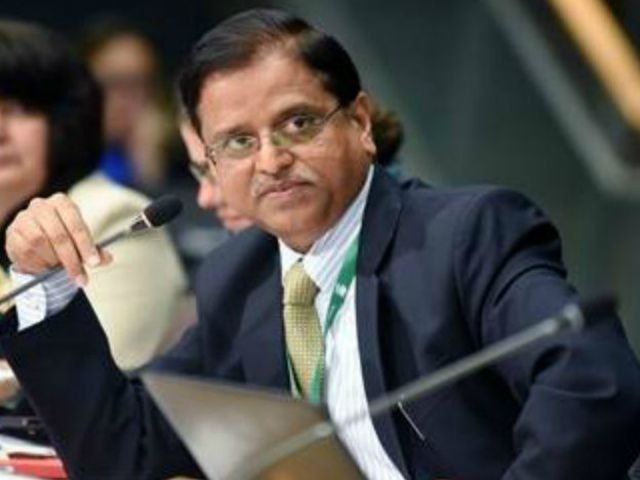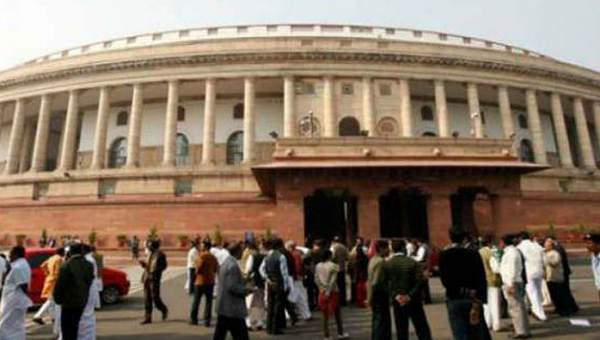
by admin | May 25, 2021 | Corporate Jobs, Economy, Employment, Government Jobs, News, Politics, Private Jobs

Subhash Chandra Garg
By Manish Gupta and Vishav,
New Delhi : Asserting India’s fast economic growth is not without generation of jobs, Economic Affairs Secretary Subhash Chandra Garg said the country actually faces shortage of capital more than the scarcity of jobs.
While most Indians have a job and are earning something, the problem is that many of them may be earning lower wages or may not be employed according to their qualifications, he said.
“In fact, we have the constraint that we don’t have as much capital and funds to invest so that we can do more (create more employment). The government has invested Rs 3.5 lakh crore in capital expenditure. If we have more funds, we can invest more,” Garg told IANS in an interview.
He said generating jobs relates to economic activity, which is producing goods and services, and the surest ways to generate employment is to make the economy grow and ensure the government takes up more programs of investment in the country.
“The government has carried out innumerable programmes of investment in the rural areas whether it is the ‘Prime Minister’s Awas Yojana’ where crores of houses are being constructed or large programmes of roads in rural areas and National Highway. Every house results into employment generation. There is a large programme for expanding the LPG connections and fuel delivery. All of them have the potential of generating jobs,” he said.
India is at a developing stage and there is lot of developmental work to do like construction of roads, houses and infratsructural facilities.
“It can provide a lot of demand for many, many years to come,” he said while referring to the demand for workers in the construction industry.
The construction labourer or the mistry, too, has got skills to get employed in any kind of construction work and get a job.
“If the economic activity continues, these jobs will remain. We are scratching just the surface. We need to create thousands of cities. The city infratsructure is nowhere,” Garg added.
The Secretary said India has had the highest economic growth in the last four-five years and the growth was accompanied with job generation.
Rejecting the criticism that India was experiencing jobless growth, Garg said it would only be true if the corporate profits were increasing very high compared to the proportion available to the workers. And, the growth in corporate profits was very normal, he said.
“It’s difficult to come across people who are literally unemployed. It may be a case of lower wages, more than the case of unemployment. Raising economic activity through the private sector and via government expenditure should give boost employment,” he said.
(Manish Gupta can be contacted at manish.g@ians.in and Vishav at vishav@ians.in)
—IANS

by admin | May 25, 2021 | Employment, News, Politics
 New Delhi : Opposition parties and political leaders on Monday sought to dismiss as “election gimmick” the Narendra Modi governments move to give 10 percent reservation for economically backward people in the general category, ahead of the 2019 Lok Sabha elections.
New Delhi : Opposition parties and political leaders on Monday sought to dismiss as “election gimmick” the Narendra Modi governments move to give 10 percent reservation for economically backward people in the general category, ahead of the 2019 Lok Sabha elections.
The Union Cabinet on the day approved 10 percent quota for people belonging to “unreserved categories”, including Christians and Muslims, in jobs and education with an annual income limit of Rs 8 lakh.
Questioning the legality of the move vis-a-vis the Supreme Court putting a cap of 50 per cent on reservations, the Congress called it an “election gimmick”.
“Did you (government) not think of this for 4 years and 8 months? So, obviously thought of as an election gimmick 3 months before the model code. You know you cannot exceed 50 per cent cap, so it is done only to posture that you tried an unconstitutional thing,” Congress MP Abhishek Manu Singhvi said.
“Forward reservation is a gimmick to fool people, the 50 per cent cap continues to be law,” he said citing the M R Balaji case in which the Supreme Court put a 50 per cent cap on reservations.
“Government only misleading nation. Andhra Pradesh and Rajasthan tried exceeding 50 per cent quota but was struck down by court. Modi, BJP clearly think Indian public eats grass,” said Singhvi adding that the move was a sign of the Modi’s “fear and certainty of losing 2019 elections”.
Communist Party of India’s (CPI) D Raja said the move indicated the ruling BJP’s desperation.
“What exactly they (government) have decided we don’t know. How they have defined ‘backwardness’ we don’t know. Already the Supreme Court has put a cap on reservation at 50 per cent. That has not been challenged by the Central government, which means the cap remains.
“So in this case, what Supreme Court is going to do we don’t know. There are many questions which need to be answered. They have to come before Parliament. The BJP is desperate, it is panicking and rattled. It wants to do certain things for fear of losing vote base,” said Raja.
Supreme Court advocate and nominated Rajya Sabha member K.T.S. Tulsi said: “This looks like an attempt in the direction of abolishing the entire reservation system.”
Speaking in a similar vein, former Union Finance Minister Yahswant Sinha dubbed the move as “jumla” (fake promise).
Sinha questioned the government’s intent citing legal complexities and paucity of time as the current session of Parliament is scheduled to end on Tuesday.
“The proposal to give 10 per cent reservation to economically weaker upper castes is nothing more than a jumla. It is bristling with legal complications and there is no time for getting it passed through both Houses of Parliament. Government stands completely exposed,” he said.
However, BJP leader and Union Minister of State for Finance Shiv Pratap Shukla, said the move was not aimed at placating the upper caste.
“This is not an attempt to placate the upper castes. We are trying to give them their right. We are not doing a favour to them. It is in line with Prime Minister Narendra Modi’s motto of ‘sabka sath, sabka vikas’.
“Those who do not want to get this bill passed in Parliament may go ahead. We will try to get this bill passed,” he said.
—IANS

by admin | May 25, 2021 | Corporate, Corporate Buzz, Corporate Jobs, Employment, Private Jobs
 Bharatpur : Leading heritage hoteliers in Rajasthan on Friday said hospitality industry in the state can play a big role in ensuring dignified job opportunities for the state’s available work force of over two crore.
Bharatpur : Leading heritage hoteliers in Rajasthan on Friday said hospitality industry in the state can play a big role in ensuring dignified job opportunities for the state’s available work force of over two crore.
On the second day of the 7th Annual Convention of the Indian Heritage Hotels Association (IHHA) held in Bharatpur on Friday, IHHA President Gaj Singh of Jodhpur said protecting the built heritage and conserving the local traditional and cultural values of communities is a must for sustainable development.
“The industry needs to continuously innovate keeping in mind the architecture and historically significant features of heritage properties to generate new activities for the tourists,” Singh said.
The convention also took up this year’s theme of ‘Reinventing India as a Heritage Destination’. Conference Chairman and Honorary Vice President IHHA, Steve Borgia said: “We must realise that our heritage is in danger. Without heritage, there will be no tourism and no stories left to tell the visitors.”
Co-Founder and Chair of Neemrana Hotels, Aman Nath, contended that it is the government vision and the citizens’ aspirations that need reinventing “not the country as the destination.”
“Hoteliers should create an experience which is so unique that it remains with the people throughout their lives,” Nath said.
Head/Chair at Australian Museums, Vinod Daniel, highlighted global approaches in managing heritage, both tangible and intangible. He also threw light on several best practices both on national and state level. Placing emphasis on curating a well-devised strategy, he said the plan needs to be implemented over several political cycles.
Author of Destination India, International Tourism Consultant, Navin Berry, said over the decades the understanding of tourism has dramatically enlarged and has transformed into a completely different entity.
“From sightseeing, it has expanded to cover a much wider gamut of activities. It encompasses weddings, experiential tourism, among others. While travel has become a hassle-free exercise owing to technology, the tourism industry itself has been found reluctant in chasing these new streams,” Berry said.
In her presentation, Director, Preservation of Sites and Monuments- National Heritage Board, Singapore, Jean Wee, shared some of Singapore’s experiences as well as reflections on how some projects from around the world have achieved success.
She said often heritage preservation brings out the worst in everyone as it starts with a major difference in opinion. “However, preservation must be a shared pre-occupation. It should offer all stakeholders a value proposition for commitment, participation and support,” she said.
Director, Department of Archaeology and Museums, Government of Telangana, N.R. Visalatchy outlined the efforts being made for preservation and excavation of monuments in the state.
—IANS

by admin | May 25, 2021 | Business, Employment
 By Divya Jain,
By Divya Jain,
New Delhi : Twenty-four-year-old Abhishek Mukherjee was offered a job by a reputed private firm during a campus recruitment drive. The young professional was eager to join his new workplace and showcase some of the skills that he mastered in college and put them to good use.
However, certain tasks that Abhishek was asked to perform at his workplace were beyond his academic knowledge. Although he had the willingness to learn, the lack of training made him a poor performer.
Often, the skills acquired in an educational institute differ from those required for the job. This means educational institutions should look beyond academics and offer students real-time experiences, where they are able to gain first-hand exposure of working in the real world. To some extent, such programmes can help students get a taste of the actual professional world and help them establish critical networking connections. However, it is workplace training that can enable employees to acquire new and specific skills for a certain role, increase their contribution to the business and build their self-esteem.
The skill sets required for jobs are ever-changing and it is the responsibility of companies to plug the skill gap between education and employment. Offering the right training to employees will help in strengthening their skills, enhancing their capabilities and acquiring new knowledge. The companies that invest time and money in developing and expanding the knowledge of their employees bring in more productivity and are able to position themselves better in the larger business landscape.
Here’s a look at how on-the-job training can prove to be a worthwhile investment for companies and equip employees with the right set of skills:
Helps tackle shortcomings: While one employee maybe good at calculations and market segmentation, another may prove her excellence in ideation and churning out new strategies. Every individual will have some shortcomings and it is timely training and development programmes that can upskill employees to perform different tasks with the minimum required skill. Workplace training plays a pivotal role in bridging the skill gap and keeping employees on the cutting edge of industry developments
Increases productivity: In a rapidly-evolving job landscape, employees need to be trained and taught about new technologies and their applications. With training and development, employees can stay up-to-date, use new technologies and give up on the old ways of performing a task. They can finish a task faster and show improved results with the right training. It will also give them confidence and enable them to adopt new and better ways to achieve their goals and objectives
Boosts employees’ morale: Lack of guidance often kills the morale of employees. Training and development programmes not only improve the skills of employees but also boost their morale, thereby making them happy and leading to longer tenures. Apart from breaking the monotony in the workplace, training programmes offer employees a learning platform where they are able to master new skills and become more marketable.
Encourages creativity: With training and upskilling, employees are able to think outside the box and widen their thinking capabilities, hone their communication skills and develop new skills that can improve a company’s competitive edge. Such programmes are the best ways to promote innovation and improve employee involvement.
Enhances company reputation and profile: Offering the right training and development programme makes the company stand out in the recruitment sphere. Employees are likely to feel valued if they are being invested in, and they work harder to exceed expectations. However, the company should adopt stronger and successful training strategies that help them build their brand name and enable them to emerge as a sought-after firm among employees.
(Divya Jain is CEO of Safeducate)
—IANS

by admin | May 25, 2021 | Corporate Jobs, Employment, Markets, Online Marketing, Private Jobs, Technology
 New Delhi : The outlook for recruitment activity is positive for the second half of 2018, a report of the job portal Naukri.com said on Monday.
New Delhi : The outlook for recruitment activity is positive for the second half of 2018, a report of the job portal Naukri.com said on Monday.
However, the Naukri Hiring Outlook Survey said the recruiters are concerned about the lack of talent for new jobs.
“As many as 70 per cent recruiters (participating in the survey) agreed to increased hiring activity in the second half of the year with both replacement hiring and new jobs creation taking place simultaneously as against 60 per cent last year,” the report said.
While there is optimism in terms of job creation and growth, there also exist concerns among the recruiters about the availability of the right talent for new jobs, it added.
The report further said layoffs are expected to be “negligible” during the period. Attrition rate, too, is likely to decline with half of the recruiters surveyed expected it to be less than 10 per cent.
“Attrition for people with more than eight years of experience at senior-level profiles was predicted by just one out of every 10 recruiters. On the other hand, two-thirds of the recruiters thought attrition will be highest for people with one to eight years of experience,” it added.
—IANS





